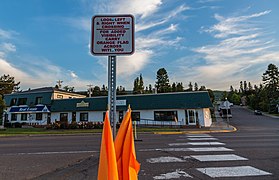| The examples and perspective in this article deal primarily with the United States and do not represent a worldwide view of the subject. You may improve this article, discuss the issue on the talk page, or create a new article, as appropriate. (October 2023) (Learn how and when to remove this message) |

A pedestrian crossing flag (PCF) also known by their brand name, See Me Flags, are flags that are used by pedestrians to increase visibility and alert drivers of their presence while they cross the street.
History
The first pedestrian crossing flags were used around 2000 at pedestrian crossings in Salt Lake City. The flags are meant to be used by crossing pedestrians to alert drivers of their presence while crossing to avoid being hit by a car. The program started by promoting 100 crosswalks. Texas Tech University reported that the flags made cars yield 74% of the time at four sites.
The flags started being used by other cities in the United States. Cities such as Kirkland, Washington, McCall, Idaho, Berkeley, California, Las Vegas, Nevada, Cupertino, California and Seattle, Washington had sponsorships for pedestrian crossing flags at crosswalks. Seattle ended the program in 2008 after not much usage by pedestrians.
Criticism
Bloomberg News described the use of pedestrian crossing flags as "demeaning", and make pedestrians feel embarrassed for needing to carry a flag for walking.
A statistic from Berkely says that only 2% of pedestrians used the crossing flags. Multiple collisions still occurred after the flags were installed into cities; the city of Bridgeport, Connecticut investigated eleven crashes involving thirteen people walking, with one case resulting in death. The flags also tend to be stolen. The flags are moved by which direction pedestrians walk by, which can cause the flags to end on one side with none on the other.
Gallery
- Pedestrian crossing flags
-
 Box of orange pedestrian crossing flags in Grand Marais, Minnesota, 2017
Box of orange pedestrian crossing flags in Grand Marais, Minnesota, 2017
-
 Box of yellow pedestrian crossing flags in Japan, 2013
Box of yellow pedestrian crossing flags in Japan, 2013
References
- "Pedestrian Safety". Transportation. Retrieved 2023-08-03.
- ^ Davies, Alex. "U.S. City Thinks Having Pedestrians Carry Flags Will Keep Them Safe". Wired. ISSN 1059-1028. Retrieved 2023-08-03.
- ^ "Pedestrian Crossing Flags – Transportation | seattle.gov". www.seattle.gov. Retrieved 2023-08-03.
- Wei, Dali; Xu, Hao; Wesley, Kumfer; Liu, Hongchao; Wang, Ziyang. "Vehicular Traffic Capacity at Unsignalized Crosswalks with Probabilistic Yielding Behavior" (PDF). Texas Tech University Press.
- MYLLENBECK, KRISTI (9 December 2016). "Cupertino: Bright orange flags for pedestrians placed at 5 intersections". The Mercury News.
- Clark, Sheila; Coughenour, Courtney; Bumgarner, Kelly; de la Fuente-Mella, Hanns; Reynolds, Chantel; Abelar, James (January 2019). "The Impact of Pedestrian Crossing Flags on Driver Yielding Behavior in Las Vegas, NV". Sustainability. 11 (17): 4741. doi:10.3390/su11174741. ISSN 2071-1050.
- "Can Waving Orange Flags Really Make Pedestrians Safer?". Bloomberg.com. 2014-09-09. Retrieved 2023-08-03.
- Lofton, Shelby (8 June 2023). "Pedestrian crossing flags 'disappearing at alarming rate'". KSL-TV.
- Skahill, Patrick (2014-06-18). "City of Bridgeport Pilots New "Crosswalk Flag" Program". Connecticut Public. Retrieved 2023-08-03.
- "Pedestrian Flag Pilot Program | City of Hastings, MN". www.hastingsmn.gov. Retrieved 2023-10-22.